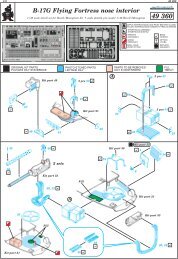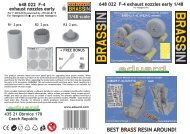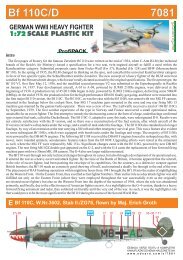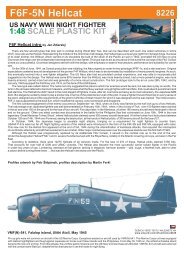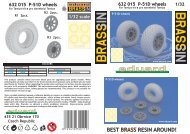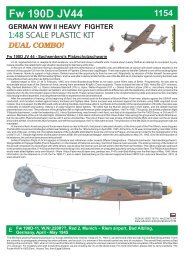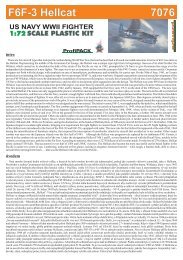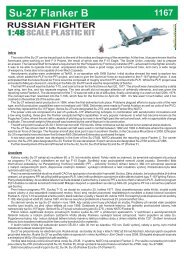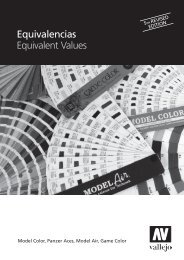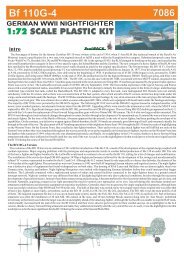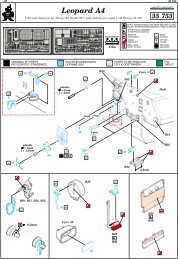Create successful ePaper yourself
Turn your PDF publications into a flip-book with our unique Google optimized e-Paper software.
Bf 109E-3 <strong>3002</strong>GERMAN WWII FIGHTER1:32SCALEPLASTICKITBf 109 introNo other aircraft of the German Luftwaffe is so intimately connected with its rise and fall in the course of the Second World War than the MesserschmittBf 109. This type, by whose evolution outlived the era in which it was conceptualized, bore the brunt of Luftwaffe duties from the opening battles of Nazi Germanythrough to her final downfall. The history of the aircraft begins during 1934-35, when the Reich Ministry ofAviation formulated a requirement for the development ofa single-engined monoplane fighter. Proposals were submitted by Arado, Heinkel, Focke-Wulf and Bayerische Flugzeugwerke. The last mentioned firm featureda technical director named Professor Willy Messerschmitt, who was riding a wave of popularity based on the success of his recent liason aircraft, the Bf 108. Hisgoal was to conceive of an aircraft with the best possible performance for the specified weight, size, and aerodynamic qualities. Over the subsequent months,several prototypes were built that served first and foremost in development flights and further modifications. The aircraft was relatively small, and compared to theprevailing trends of the time, docile with revolutionary features such as low wing design, the use of a retractable landing gear, a wing with a very narrow profile,wing slats, landing flaps, weapons firing through the prop arc, and so on. Even the enclosed cockpit and the method of construction were not very common justfour years prior to the beginning of the Second World War. At its conception, the Bf 109 was a very promising asset despite some powerplant troubles. These weresolved by the introduction of the DB601. This engine, together with its extrapolated development DB605, are umbilically connected to the types success. Thesetwo-row, twelve cylinder inverted V engines powered several tens of thousands of '109s in over 25 versions and variants.The first combat use was by three developmental Bf 109s in the Spanish Civil War, where they were delivered in December, 1936. The pre-series airframeswere to, first of all, validate the aircraft's abilities in modern aerial combat. Shortly thereafter, production machines in the form of the Bf 109B-1 began to reach2./J.88, the Legion Condor. The desire of Germany to demonstrate her aerial prowess to potential foes was advanced further in international sport meets.The triumphs attained in Zurich in the summer of 1937 were complemented several months later by grabbing the speed record of 610.95 kph.In very short order, the progressive developments represented by the C, D and E versions appeared. Despite this, the delivery of the types to combat units did notsustain a rate that was desired by military brass. Even by August, 1938, the Bf 109 accounted for less than half of the 643 front line fighters in service. The latermonths saw an increase in these rates. By the time of the invasion of Poland (which saw the participation of only a little more than 200 aircraft)the Luftwaffe possessed the best fighter produced in continental Europe. With both a qualitative and quantitative advantage, the fighter wing of the Luftwaffeentered the Polish campaign, the first defenses of the Fatherland, Blitzkrieg against the West, and the Battle fro France. With one foot in the door that wasthe English Channel, the Luftwaffe embarked on the attacks on Britain in the summer months of 1940. Here, the first weakness of the Bf 109 was revealed:the inability to carry drop tanks that would have enabled the type to effectively escort bombers to England. This was one of the factors that made the defeat of theLuftwaffe in the Battle of Britain possible. Experiences gained in 1940 led to the development of the 'F' version prior to the spring of 1941.The elegance of the Bf 109 crested with the 'Friedrich'. Following a largely defensive stance over the Channel and northern France, the Bf 109F took ona more offensive role in Operation Barbarosa in the east, and in northern Africa. In later duties with the 'Jagdwaffe' during the second phase of the war in the east,and in the 'Defense of the Reich' from 1943 to 1945, the Bf 109 served in the form of the 'G' version, followed by the 'K'. Even if by the end of the war it was clear thatthe development of the Bf 109 was exhausted, during its combat career, the type was able to keep pace with the foes that it encountered. Besides its primaryfunction as fighter, the Bf 109 also appeared as a fighter-bomber, reconnaissance platform, night fighter, trainer and rammjager.The disappearance of the Bf 109 from the skies over Europe was not spelled out by the end of the war. Bf 109s served in Balkan countries (Yugoslavia andBulgaria), several examples were in Swiss service up to 1949, and many flew in the air force of Czechoslovakia in both original form with a DB605 powerplant andas aircraft built out of necessity with surplus Jumo 211s. The latter type also served as the first fighter to fight for the independence of the newly formed state ofIsrael. Finland retired the type as recently as 1954, and Spain didn't retire its HA-1109-1112, rebuilt Bf109s, until 1967. The legendary low-wing fighter of ProfessorWilly Messerschmitt survived the state that developed it.eduardThe Bf 109E-3 versionThe E-3 was the sister version to the E-1 developed from the prototype Bf 109V15. The 'Emil' was the first version where the DB 601 replaced the Jumo 210.Not only did the front of the aircraft change significantly with this modification, but the engine drove a three blade, variable pitch propeller, and gave a 50% betterperformance. Standard armament of the E-3 comprised twin MG17 machine guns above the engine, and 20mm MG/FF cannon in the wings (both the E-1 and theE-3 were produced simultaneously, differing only in wing armament). There was a total of approximately 6000 Emils built. Compared to its adversaries,comprising chiefly of the D-520, Spitfire and Hurricane, the E-3 enjoyed an advantage in climb rate, armament, stability as a gun platform, and having fuelinjection. Its main drawback ended up being short range, allowing only a few minutes' combat before the pilot needed to break off and head back to his home field.Shortly after the Battle of Britain, the Bf 109E-3 and E-1 were replaced by later 'E' and the 'F' versions.15a H65 H7018 20 2137+38 ? 4160H1162H1162E Uffz. Karl Wolff, 3./JG 52, Pihen/Calais, France, August 1940FOR COMPLETE PROFILE PLEASE REFERwww.eduard.com/info/photos/<strong>3002</strong>A very attractive scheme was carried by Bf 109E-3 White ‘15’, with which Uffz. Karl Wolff crashed on landing on August 30, 1940. It carried the standard scheme ofRLM 02/71/65, and the light blue 65 extended up the fuselage sides. The light blue, which also wrapped around the leading edges of the wings, was subdued with oversprayof colors used on the upper surfaces. Furthermore, the aircraft received white paint on surfaces such as the nose, rudder and wingtips, used first and foremost as quickidentification features. The I. Gruppe JG 52 unit emblem appeared on the nose of the plane. A month after his hard landing in White ‘15’, Uffz. Wolff was shot down and takenprisoner.Jagdgeschwader 52 became the Luftwaffe’s most successful fighter unit mainly due to its operations over the Eastern Front. However, its successes began during the Battleof France, and later, the Battle of Britain. By the end of 1940, the unit’s pilots had already racked up 177 kills. On the other hand, losses were quite high as well. Just during theBattle of Britain, the unit lost 53 pilots. The unit was also odd in that its equipment over the course of the war was composed exclusively of Bf 109s.Additional sources: Classic Colours: Jagdwaffe / Attack in the West and Battle of Britain series by Eric MombeekČESKOU VERZI TEXTU A KOMPLETNÍKAMUFLÁŽNÍ SCHÉMA NALEZNETE NAwww.eduard.com/info/photos/<strong>3002</strong>
ATTENTION UPOZORNĚNÍACHTUNG ATTENTIONINSTRUCTION SIGNSINSTR. SYMBOLYINSTRUKTION SINNBILDENSYMBOLESOPTIONALVOLBAFACULTATIFNACH BELIEBENBENDOHNOUTPLIER SIL VOUS PLAITBITTE BIEGENOPEN HOLEVYVRTAT OTVORFAIRE UN TROUOFFNENSYMETRICAL ASSEMBLYSYMETRICKÁ MONTÁŽMONTAGE SYMÉTRIQUESYMMETRISCHE AUFBAUNOTCHZÁŘEZL INCISIONDER EINSCHNITTREMOVEODŘÍZNOUTRETIRERENTFERNENAPPLY EXPRESS MASKAND PAINTPOUŽÍT EXPRESS MASKNABARVITPARTS DÍLYTEILE PIECESPLASTIC PARTSA> B> D>E> F> G>J>PE - PHOTO ETCHED DETAIL PARTSeduardCOLOURS BARVYFARBEN PEINTURE2GSi Creos (GUNZE)AQUEOUSH4H11H12H47H64Mr.COLORC4C62C33C41YELLOWFLAT WHITEFLAT BLACKRED BROWNC17 DARK GREENRLM 71H65 C18 BLACK GREEN RLM 70H70 C60 GRAYRLM 02H77C137 TIRE BLACKAQUEOUS Mr.COLORH344RUSTC113 YELLOW RLM 04C116 BLACK GRAY RLM 66C117 LIGHT BLUE RLM 76Mr.METAL COLORMC213STEELMC214MC218DARK IRONALUMINIUM
F9F14H70C60RLM02 GRAYH70C60RLM02 GRAYH70C60RLM02 GRAYPE34PE40MC213STEELF35F17F3H70C60RLM02 GRAYPE9F36A1H70C60RLM02 GRAYH70C60RLM02 GRAYD9F14H70C60RLM02 GRAYF1H70C60RLM02 GRAYF13A2H70C60RLM02 GRAYMC214DARK IRONF24PE25H70C60RLM02 GRAYD4H70C60RLM02 GRAYF39F7PE33MC214DARK IRONPE33F11MC214DARK IRONPE32E11H70C60RLM02 GRAYH70C60RLM02 GRAYH70C60RLM02 GRAYA12H70C60RLM02 GRAY3
F37PE12PE16PE10F30F16F38PE21PE23PE20PE12PE18PE31PE19PE21H70C60RLM02 GRAYPE11PE22D23PE31D21H70C60RLM02 GRAYE16PE26H12C33FLAT BLACKF25H70C60RLM02 GRAYE12F12F32H12C33FLAT BLACKH70C60RLM02 GRAYF33H70C60RLM02 GRAYPE35MC213STEELH70C60RLM02 GRAYH70C60RLM02 GRAYPE14F19PE8PE7PE4PE17PE1PE6PE5E19F19C116RLM66 GRAYE19F26H70C60RLM02 GRAYF22H12C33FLAT BLACK4
G34H77C137TYRE BLACKG19MC218ALUMINIUMG2G9G26MC214DARK IRONH70C60RLM02 GRAYG18H70C60RLM02 GRAYG10H70C60RLM02 GRAYTO BUILD THE MODEL WITH THE CLOSED ENGINE COWLING AND THE WEAPON COVER, YOU CAN’T INSTAL THE COMPLETEENGINE AND WEAPON ASSEMBLY. FOR MORE INFO PLEASE REFERwww.eduard.com/info/photos/<strong>3002</strong>POKUD CHCETE POSTAVIT MODEL SE ZAVŘENÝMI KRYTY MOTORU A TRUPOVÝCH ZBRANÍ, NELZE INSTALOVATVŠECHNY DETAILY MOTORU A KULOMETŮ. PRO VÍCE INFORMACÍ SE PODÍVEJTE NAMC218www.eduard.com/info/photos/<strong>3002</strong>ALUMINIUMG27G29G30G1MC214DARK IRONG22MC214DARK IRONG8G32H344RUSTG12 5 pcs.G33H344RUSTG15MC214DARK IRONMC214DARK IRONG23MC218ALUMINIUMG24G16F4G17H344RUSTG12 5 pcs.H344RUSTG15H12C33FLAT BLACKG13G3 - FIRSTG7 - NEXTG3 - PRVNÍG7 - DRUHÝMC218ALUMINIUMG7G31H70C60RLM02 GRAYG14G3G25MC218ALUMINIUMH12C33FLAT BLACKH77C137TYRE BLACKH70C60RLM02 GRAYG4MC218ALUMINIUMG315
E24G16ALTERNATIVE ASSEMBLY FORCLOSED ENGINE COWLING.ALTERNATIVNÍ SESTAVA PROZAVŘENÝ KRYT MOTORU.A2F2H70C60RLM02 GRAYA1F2D23D5D20D8D2H70C60RLM02 GRAYF40H70C60RLM02 GRAYD11H77C137TYRE BLACKC116RLM66 GRAYD3D17D19E13PE39E10D186
E5H77C137TYRE BLACKH77C137TYRE BLACKE8B2MC218ALUMINIUMMC218ALUMINIUMB1D14B2D12MC214DARK IRONF31E20MC218ALUMINIUME15B1MC218ALUMINIUMMC214DARK IRONF31B3MC214DARK IRONPE29PE27MC214DARK IRONPE27PE28B3H70C60RLM02 GRAYH70C60RLM02 GRAY7
D22D7D6H70C60RLM02 GRAYG5MC214DARK IRONG28D13G6H70C60RLM02 GRAYH70C60RLM02 GRAYG5G28MC214DARK IRONG20H70C60RLM02 GRAYH70C60RLM02 GRAYG6H70C60RLM02 GRAYG21F48PE30
F20H77C137TYRE BLACKF8H77C137TYRE BLACKC116RLM66 GRAYF27F8C116RLM66 GRAYE7C116RLM66 GRAYF27C116RLM66 GRAYF20MC218ALUMINIUMH70C60RLM02 GRAYMC218ALUMINIUMF5H70C60RLM02 GRAYF18H70C60RLM02 GRAYE6F5H70C60RLM02 GRAYF10F6F34E3B3PE37H70C60RLM02 GRAYD13E3D16PE37H70C60RLM02 GRAYE2H70C60RLM02 GRAYE2D15H70C60RLM02 GRAYE18F6E18H70C60RLM02 GRAYA1, A2D229
E9ALTERNATIVE ASSEMBLY FOR CLOSED ENGINE COWLING.ALTERNATIVNÍ SESTAVA PRO ZAVŘENÝ KRYT MOTORU.OPENCLOSEDA6H344RUSTG15H344RUSTG12 5 pcs.E21PE38A1OPENCLOSEDE26MC214DARK IRONF29E14H344RUSTG12 5 pcs.H344RUSTG15A11A5F4A4C116RLM66 GRAYF21J2H47C41RED BROWNH12C33FLAT BLACKPE24PE2PE3G19C116RLM66 GRAYE1710J2H47C41RED BROWNH12C33FLAT BLACKH12C33FLAT BLACK
E4 - MARKINGH70C60RLM02 GRAYE4EONLYPE13H70C60RLM02 GRAYH70C60RLM02 GRAYPE15J3PE15F28PE15 - MARKINGEONLYOPENPE42SM01SUPER CHROMH70C60RLM02 GRAYJ1PE41, PE43 -MARKINGE ONLYH70C60RLM02 GRAYPE43PE42H47C41RED BROWNCLOSEDJ4F23H70C60RLM02 GRAYF23J1J1 J3 J4PE36H12C33FLAT BLACKH65C18RLM70 GRAYD1MC218ALUMINIUMMC218ALUMINIUME23J3PE36J4E2211
A Oblt. Josef Priller, Staffelkapitän 6./JG 51, France, Autumn 1940Yellow ‘1’, W.Nr. 5057, was flown by the commander of 6. Staffel JG 51, Josef Priller, and underwent several camouflage color modifications through its career.According to some sources, the initial scheme was composed of RLM 70/71/65. However, it is easier to confirm later variations, when the underside light blue wasextended up the sides of the fuselage, and quite high up at that. Later, this color was subdued by the application of irregular squiggles of RLM 02 and 71. Furthermore,the upper surfaces of the wing, originally composed of broken lines, were augmented in a similar manner as the fuselage sides. This was the appearance of the aircraftin the fall of 1940, and as depicted by our profile. At the time, the aircraft also received a yellow nose section and rudder. The extent of the front end yellow coloring is upfor speculation. Some sources suggest this as it appears on the boxtop of this kit, while others claim that the yellow only covered the engine cowl and spinner, as shownin this profile. The emblem of II./JG 51 ‘Gott strafe England!’ (God punish England!) shown on the rear of the fuselage, is sprayed on without the usual whitebackground, only with the black border around a black raven with an umbrella, symbolizing Neville Chamberlain. The Staffel marking in the form of the Ace of Heartssubsequently was used on Priller’s later aircraft as a personal marking. Here, it does not yet bear the well-known ‘Jutta’ inscription. The kill marks denoting Priller’saerial victories on the tail in the form of vertical tabs with dates, partially obscured the Swastika. Beer lover Josef Priller attained 101 aerial victories in 1,307 operationalflights between 1939 and 1945. The pictured aircraft was later inherited by another well-known Luftwaffe pilot, Hptm. Herbert Ihlefeld, who used it in 1941 in the Balkancampaign.Additional sources: Classic Colours: Jagdwaffe / Attack in the West and Battle of Britain series by Eric MombeekČESKOU VERZI TEXTU NALEZNETE NAwww.eduard.com/info/photos/<strong>3002</strong>23H64 H6517 28 18 2139+40 ? 4231+34113H706027113H651830H6417H70603033S732117S7H1162H641739+40 ? 4231+35H6521 18H6417 2825RLM 04YELLOW 113117H70H6527 601812RLM 76117RLM 02H7060RLM 71H6518RLM 70H6417eduard
B 3./JG 51, Mannheim-Sandhofen, Winter 1939-1940The illustrated aircraft is an example of the camouflage scheme and national marking application introduced at the end of 1939, specifically during the 'Sitzkrieg' periodand during the defense of Germany against the first retaliatory raids by the RAF. The aircraft is painted in the standard scheme of RLM 70 and 71 on the upper surfaces.The paint is affected by heavy weathering and wear. The lower surfaces are in light blue, RLM 65. An interesting feature on this aircraft, and occasionally seen onothers, is the very large rendering of the national marking on the wings. The fuselage Balkenkreuz also has a more slender centre cross segment. The Totenhandmarking below the cockpit is the 3./JG 51 unit insignia, while the Kitzbuheler Gams marking, which was used by I./JG 51 from its beginnings, was a reminder of theinflux ofAustrian pilots to the unit in 1938, at a time when it carried the markings of I./JG 233.Additional sources: Classic Colours: Jagdwaffe / Attack in the West and Battle of Britain series by Eric MombeekČESKOU VERZI TEXTU NALEZNETE NAwww.eduard.com/info/photos/<strong>3002</strong>1135H65 H649a 16 10 18 17 37+38 ? 41117113113H65183a+3b+3cH6417H65184a+4b+4cH64171a+1b113S72a+2b117S7H6417H641737+38 ? 41H64 H6517 18 10 16 9b 5RLM 04YELLOW 113RLM 76117RLM 02H7060RLM 71H6518RLM 70H6417eduard13
C 1./JG 2, Bassenheim, Germany, May 1940The illustrated White ‘7’ flew in the spring of 1940 with Staffel JG 2 under the command of Spanish Civil War veteran Oblt. Otto Bertram. The aircraft carries the standardperiod camouflage scheme consisting of RLM 02/71 on the upper surfaces. The lower surface light blue RLM 65 extended quite high up the fuselage sides.An oddity onthis aircraft is the application of older national markings on this newer scheme, including the smaller fuselage crosses with very thin border segments and theapplication of the Swastika such that it covered both the rudder and the fin. The emblem of JG 2 Richthofen appeared on both sides of the fuselage under the cockpit.Similarly, the Staffel marking of a leashed dog ‘Bonzo’ appeared on both sides, and was developed by Otto Bertram. The template for the marking was the comiccharacter ‘Bonzo the Dog’, by the Brit George Studdy who’s drawings paradoxically appeared on aircraft of both sides.Additional sources: Classic Colours: Jagdwaffe / Attack in the West and Battle of Britain series by Eric MombeekČESKOU VERZI TEXTU NALEZNETE NAwww.eduard.com/info/photos/<strong>3002</strong>7H651812?14?3613 11H706037+38 ? 41117117H65 H706 18 6066S76117H6518H7060S7H6417H641737+38 ? 41 H70H6560 11 181312?14?36 811714RLM 76117RLM 02H7060RLM 71H6518RLM 70H6417eduard
D Obstlt. Hans-Hugo Witt, Geschwaderkommodore JG 26, Dortmund, Germany, April 1940This aircraft, which carried an unusual camouflage scheme for the noted period, was flown by the CO of JG 26, Obstlt. Hans-Hugo Witt in April, 1940. Upper surfaceswere composed of fields of RLM 02 and 71, while the bottom carried the standard RLM 65. The Geschwaderkommodor tactical marking was supplemented by asimplified version of the ‘Schlageter’ emblem, the unit marking of JG 26. The mounted rider was marking of Stab/JG 26 and was found exclusively on the left side of thefuselage. Jagdgeschwader 26 participated in the Battle of France during this timeframe. Hans-Hugo led the unit until June 23, 1940, when he left at the age of 39 to takeon several command functions in the Luftwaffe leadership. Witt is also known for being a survivor of the ill-fated Hindenburg flight on May 6, 1937.Additional sources: Classic Colours: Jagdwaffe / Attack in the West and Battle of Britain series by Eric MombeekČESKOU VERZI TEXTU NALEZNETE NAwww.eduard.com/info/photos/<strong>3002</strong>H6518H7029 26 24 22 60 17 37+38 ? 41117H116218H6518H70601819S719117S7H6417H641737+38 ? 41 H70H6517 60 22 182429117RLM 76117RLM 02H7060RLM 71H6518RLM 70H6417eduard15
E Uffz. Karl Wolff, 3./JG 52, Pihen/Calais, France, August 1940A very attractive scheme was carried by Bf 109E-3 White ‘15’, with which Uffz. Karl Wolff crashed on landing onAugust 30, 1940. It carried the standard scheme of RLM02/71/65, and the light blue 65 extended up the fuselage sides. The light blue, which also wrapped around the leading edges of the wings, was subdued with oversprayof colors used on the upper surfaces. Furthermore, the aircraft received white paint on surfaces such as the nose, rudder and wingtips, used first and foremost as quickidentification features. The I. Gruppe JG 52 unit emblem appeared on the nose of the plane. A month after his hard landing in White ‘15’, Uffz. Wolff was shot down andtaken prisoner.Jagdgeschwader 52 became the Luftwaffe’s most successful fighter unit mainly due to its operations over the Eastern Front. However, its successes began during theBattle of France, and later, the Battle of Britain. By the end of 1940, the unit’s pilots had already racked up 177 kills. On the other hand, losses were quite high as well.Just during the Battle of Britain, the unit lost 53 pilots. The unit was also odd in that its equipment over the course of the war was composed exclusively of Bf 109s.Additional sources: Classic Colours: Jagdwaffe / Attack in the West and Battle of Britain series by Eric MombeekČESKOU VERZI TEXTU NALEZNETE NAwww.eduard.com/info/photos/<strong>3002</strong>H6518 20 21H706037+38 ? 41H116215aH1162OUTLINEH116218H6518H7060117H1118 62H116219H1162S719117H1162H1162S7H6417H6417H116237+38 ? 41 H70H6560 21 182015b117WHITEH1162RLM 76117RLM 02H7060RLM 71H6518RLM 70H6417eduard
Bf 109E-3 STENCIL DATAS30S16S37S34RotringS29S23S38?S4387S27 S27 S27S11S45S10S42S44S24?S32S28S16S40S39S22aS26S20aS14S17S31S19S19S31S18S18S12S15S6S23S44S28S20bS24 ? S32S26S22bS35S1516 eduard© EDUARD M.A. 2009 www.eduard.com Printed in Czech RepublicS36



